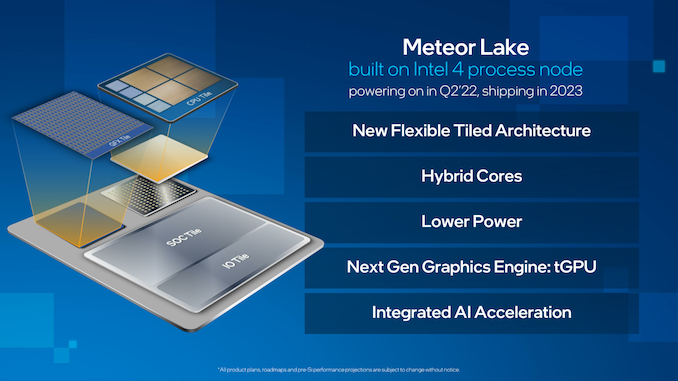Intel: Meteor Lake Chiplet SoC Up and Running
by Ryan Smith on April 29, 2022 4:30 PM EST- Posted in
- CPUs
- Intel
- Meteor Lake
- Intel 4

Alongside Intel’s regular earnings report yesterday, the company also delivered a brief up on the state of one of their most important upcoming products, Meteor Lake. Intel’s first chiplet/tile-based SoC, which completed initial development last year, has now completed power-on testing and more. The news is not unexpected, but for Intel it still marks a notable milestone, and is important proof that both Meteor Lake and the Intel 4 process remain on track.
Meteor Lake, which is slated to be the basis of Intel’s 14th generation Core processors in 2023, is an important chip for the company on several levels. In terms of design, it is the first chiplet-based (or as Intel likes to put it, “disaggregated”) mass-market client SoC from the company. Intel’s roadmap for the Core lineup has the company using chiplet-style SoCs on a permanent basis going forward, so Meteor Lake is very important for Intel’s design and architecture teams as it’s going to be their first crack at client chiplets – and proof as to whether they can successfully pull it off.
Meanwhile Meteor Lake is also the first client part that will be built on the Intel 4 process, which was formerly known as Intel’s 7nm process. Intel 4 will mark Intel’s long-awaited (and delayed) transition to using EUV in patterning, making it one of the most significant changes to Intel’s fab technology since the company added FinFETs a decade ago. Given Intel’s fab troubles over the past few years, the company is understandably eager to show off any proof that its fab development cycle is back on track, and that they are going to make their previously declared manufacturing milestones.
As for this week’s power-on announcement, this is in-line with Intel’s earlier expectations. At the company’s 2022 investor meeting back in February, in the client roadmap presentation Intel indicated that they were aiming for a Q2’22 power-on.
We have officially powered-on our first disaggregated product: Meteor Lake. An incredible milestone resulting from the efforts of so many across @intel. Congratulations, team! pic.twitter.com/eKvHzDqSiu
— Michelle Johnston Holthaus (@MJHolthaus) April 29, 2022
In fact, it would seem that Intel has slightly exceeded their own goals. While in a tweet put out today by Michelle Johnston Holthaus, the recently named EVP and GM of Intel’s Client Computing Group, announced that Meteor Lake had been powered on, comments from CEO Pat Gelsinger indicate that Meteor Lake is doing even better than that. According to Gelsinger’s comments on yesterday’s earnings call, Meteor Lake has also been able to boot Windows, Chrome, and Linux. So while there remains many months of bring-up left to go, it would seem that Meteor Lake’s development is proceeding apace.
But that will be a story for 2023. Intel will first be getting Raptor Lake out the door later this year. The Alder Lake successor is being built on the same Intel 7 process as Alder Lake itself, and will feature an enhanced version of the Alder Lake architecture.










72 Comments
View All Comments
JayNor - Saturday, April 30, 2022 - link
They've already done that type of thing before with Kaby Lake-G, with pretty decent results, but I'd expect them to show HBM stacks in the slides if they are doing this again.see yt review, "Intel Core i7-8705G Benchmarked, RX Vega M + Kaby Lake-G"
so, yeah, the ucie looks like a good idea, and cxl over ucie would be an interesting feature, but I haven't seen Intel describing any details like that for Meteor Lake.
III-V - Wednesday, May 18, 2022 - link
They were called IGPs back with Intel Clarkdale... calling it a "tGPU" is just embracing a nonsense buzzword.kpb321 - Friday, April 29, 2022 - link
I wonder if we will have a repeat of the Athlon 64 era. AMD integrated the memory controller first and had a good product for a while until Intel did the same thing but things seemed to go down hill after that. Some of that was definitely bad moves on AMD's part but some of it is just no longer having the advantage of making a change earlier. Hopefully AMD stays more competitive this time.WaltC - Saturday, April 30, 2022 - link
I think this time the hope is that Intel stays competitive...;) How amusing: "the Intel 4 process, which was formerly known as Intel’s 7nm process"...;)JayNor - Saturday, April 30, 2022 - link
Intel used tsm N5 on Ponte Vecchio compute tiles, tsm N6 on the ARC GPUs and will reportedly use TSM N3 on the Meteor Lake GPU tiles.AMD could have moved to EUV processing on Milan, but chose to stay on DUV N7. I get the impression that AMD wants to stay on proven nodes.
Intel is taking more risks with N3, but perhaps sees this as necessary to be competitive with Apple.
t.s - Tuesday, May 3, 2022 - link
I'd say more to profit oriented (older node, cheaper)tamalero - Saturday, April 30, 2022 - link
AMD was castrated then by intel's monopolistic tactics and being forced to use their supply limited and expensive foundry.I do not think Lisa would make the same idiotic mistake.
TheinsanegamerN - Monday, May 2, 2022 - link
Intel played a major part, but AMD also made multiple bone headed decisions, such as spending money on ATi or building globalfoundaries while their athlons stagnated, then rushing to release phenom when the core 2 landed and ROFLstomped athlong 64.GeoffreyA - Monday, May 2, 2022 - link
One never knows but I doubt it'll happen again that easily. Back then, AMD underestimated Intel, rested on their laurels somewhat, and weren't that aggressive with K10/Phenom. As Papermaster or someone said a while ago, it's going to be tock, tock, tock all the way now.Duwelon - Friday, April 29, 2022 - link
Hybrid cores are 99% pointless for desktops.